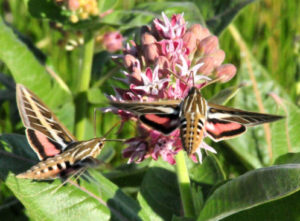
Hummingbird moth on milkweed (and there are many different varieties of milkweed to choose from when planting!) Photo by T. Koerner and courtesy of USFWS.
As I’ve mentioned before, some of the biggest issues facing moths are habitat loss and becoming the unintended target of biocontrol efforts- while we may only be able to influence the latter policy-wise, we have a lot of options when looking at moth habitat and population concerns.
When I started looking for groups that work on moth conservation, I found a huge number of local and regional options- I’m not listing them all here, but, if your area isn’t covered, it might be worth a quick internet search to find something close to you.
If you’d prefer to help moths from a distance, you can donate to the Xerces Society which works for moth and butterfly conservation in North America. Many of the other groups listed below also would appreciate more funding for their projects.
Looking to make your home or region more moth-friendly?
- Butterfly Conservation has ideas for container gardening
- Lady Bird Johnson Wildflower Center and Wild About Gardens have suggestions for moth-focused gardens
- the Somerset Wildlife Trust would like help planting and growing wild liquorice to provide habitat for the Liquorice Piercer
- Canadian Wildlife Federation has ideas for helping luna moths
- Southeastern Massachusetts Pine Barren Alliance works to protect and restore this important habitat used by moths and other animals
Want to spend some time getting up close and personal with moths?
- the UK has both a National Moth Recording Scheme and Garden Moth Scheme
- Butterfly Conservation in Northern Ireland is looking for volunteers to do butterfly and moth surveys
- you can submit sightings of moths to Butterflies and Moths of North America
- Pacific Northwest Moths has species identification resources to help you get a better sense of what moths you encounter
- there are special moth-counting events across the US right now as part of National Moth Week
There are many small groups working to support moth populations- since one of the big issues is habitat loss, creating a moth-friendly backyard can make a difference, but we also need to work at larger scales to preserve habitat so that moth populations don’t become isolated in their own tiny pockets of habitat- so, if you don’t find your area represented by the organizations above, check with community-based conservation groups near you- by expanding the breadth of habitat protection and restoration, we can give moths a fighting chance in the long-term.
